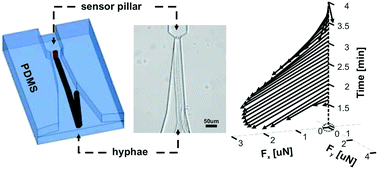Our official English website, www.x-mol.net, welcomes your
feedback! (Note: you will need to create a separate account there.)
An elastomeric micropillar platform for the study of protrusive forces in hyphal invasion
Lab on a Chip ( IF 6.1 ) Pub Date : 2017-09-22 00:00:00 , DOI: 10.1039/c7lc00725f Ayelen Tayagui 1, 2, 3, 4, 5 , Yiling Sun 1, 2, 3, 4 , David A. Collings 6, 7, 8 , Ashley Garrill 3, 4, 5 , Volker Nock 1, 2, 3, 4
Lab on a Chip ( IF 6.1 ) Pub Date : 2017-09-22 00:00:00 , DOI: 10.1039/c7lc00725f Ayelen Tayagui 1, 2, 3, 4, 5 , Yiling Sun 1, 2, 3, 4 , David A. Collings 6, 7, 8 , Ashley Garrill 3, 4, 5 , Volker Nock 1, 2, 3, 4
Affiliation

|
Oomycetes and fungi are microorganisms whose pathogenic (invasive) growth can cause diseases that are responsible for significant ecological and economic losses. Such growth requires the generation of a protrusive force, the magnitude and direction of which involves a balance between turgor pressure and localised yielding of the cell wall and the cytoskeleton. To study invasive growth in individual hyphae we have developed a lab-on-a-chip platform with integrated force-sensors based on elastomeric polydimethylsiloxane (PDMS) micro-pillars. With this platform we are able to measure protrusive force (both magnitude and direction) and hyphal morphology. To show the usefulness of the platform, the oomycete Achlya bisexualis was inoculated and grown on a chip. Growth of individual hyphae into a micro-pillar revealed a maximum total force of 10 μN at the hyphal tip. The chips had no discernible effect on hyphal growth rates, but hyphae were slightly thinner in the channels on the chips compared to those on agar plates. When the hyphae contacted the pillars tip extension decreased while tip width increased. A. bisexualis hyphae were observed to reorient their growth direction if they were not able to bend and effectively grow over the pillars. Estimates of the pressure exerted on a pillar were 0.09 MPa, which given earlier measures of turgor of 0.65 MPa would indicate low compliance of the cell wall. The platform is adaptable to numerous cells and organisms that exhibit tip-growth. It provides a useful tool to begin to unravel the molecular mechanisms that underlie the generation of a protrusive force.
中文翻译:

弹性微柱平台,用于研究菌丝入侵中的突出力
卵菌和真菌是微生物,其致病性(侵入性)生长会导致引起重大生态和经济损失的疾病。这种生长需要产生突出力,其大小和方向涉及膨胀压力与细胞壁和细胞骨架的局部屈服之间的平衡。为了研究单个菌丝的侵袭性生长,我们开发了一个芯片实验室平台,该平台具有基于弹性聚二甲基硅氧烷(PDMS)微柱的集成式力传感器。使用该平台,我们能够测量突出力(大小和方向)和菌丝形态。为了展示该平台的实用性,卵石双足双足A被接种并在芯片上生长。单个菌丝向微柱的生长显示菌丝尖端的最大总力为10μN。切片对菌丝的生长速率没有明显的影响,但是与琼脂平板上的菌丝相比,切片上的通道中的菌丝略薄。当菌丝接触到柱子时,针尖的延伸减少,而针尖的宽度增加。双性恋曲霉如果它们不能弯曲并无法在柱子上有效生长,则可以观察到它们会重新定向它们的生长方向。施加在柱子上的压力估计为0.09 MPa,如果较早测得的膨胀力为0.65 MPa,则表明细胞壁的顺应性较低。该平台适用于多种具有尖端生长的细胞和生物。它提供了一个有用的工具,可以开始揭示构成突出力产生的分子机制。
更新日期:2017-10-26
中文翻译:

弹性微柱平台,用于研究菌丝入侵中的突出力
卵菌和真菌是微生物,其致病性(侵入性)生长会导致引起重大生态和经济损失的疾病。这种生长需要产生突出力,其大小和方向涉及膨胀压力与细胞壁和细胞骨架的局部屈服之间的平衡。为了研究单个菌丝的侵袭性生长,我们开发了一个芯片实验室平台,该平台具有基于弹性聚二甲基硅氧烷(PDMS)微柱的集成式力传感器。使用该平台,我们能够测量突出力(大小和方向)和菌丝形态。为了展示该平台的实用性,卵石双足双足A被接种并在芯片上生长。单个菌丝向微柱的生长显示菌丝尖端的最大总力为10μN。切片对菌丝的生长速率没有明显的影响,但是与琼脂平板上的菌丝相比,切片上的通道中的菌丝略薄。当菌丝接触到柱子时,针尖的延伸减少,而针尖的宽度增加。双性恋曲霉如果它们不能弯曲并无法在柱子上有效生长,则可以观察到它们会重新定向它们的生长方向。施加在柱子上的压力估计为0.09 MPa,如果较早测得的膨胀力为0.65 MPa,则表明细胞壁的顺应性较低。该平台适用于多种具有尖端生长的细胞和生物。它提供了一个有用的工具,可以开始揭示构成突出力产生的分子机制。











































 京公网安备 11010802027423号
京公网安备 11010802027423号